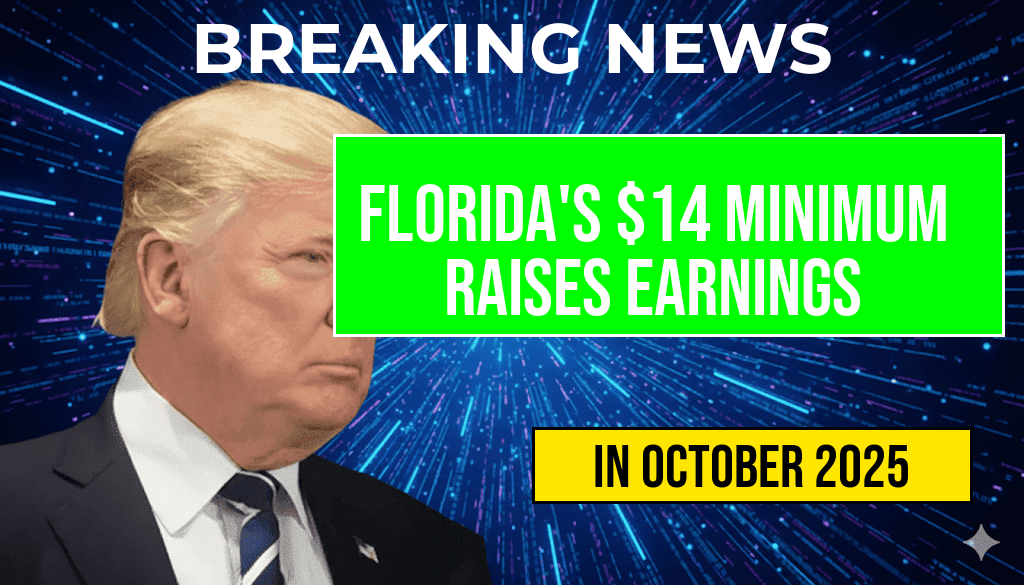Florida has implemented a significant increase to its minimum wage, raising it to $14 per hour effective immediately. This adjustment is poised to have a notable financial impact on full-time workers across the state, adding approximately $2,080 annually to the earnings of individuals working full-time at the new rate. The move aligns with Florida’s broader efforts to elevate living standards and address wage stagnation, especially amid ongoing economic recovery. As the change takes effect, employers and employees are adjusting to the new wage landscape, with some sectors experiencing immediate shifts in payroll expenses and worker compensation. This policy shift underscores Florida’s commitment to gradually increasing the minimum wage, which is expected to continue rising in the coming years in accordance with state legislation and economic conditions.
Details of the Wage Increase
The new minimum wage of $14 per hour marks a substantial jump from the previous rate of $11. This increase is part of Florida’s scheduled wage adjustments, which are designed to reach $15 per hour by September 2026. The state’s minimum wage law, enacted in 2020, mandates annual increases tied to inflation, aiming to keep pace with cost-of-living adjustments and economic growth.
Annual Earnings Impact
| Hourly Wage Before Increase | Hourly Wage After Increase | Additional Annual Earnings |
|---|---|---|
| $11.00 | $14.00 | $2,080 |
Based on a standard full-time schedule of 40 hours per week and 52 weeks per year, the wage hike results in an additional $2,080 annually for workers earning the minimum wage. This calculation assumes consistent full-time employment without unpaid time off, highlighting the wage boost’s tangible effect on annual income.
Economic and Social Implications
The increase is expected to influence various sectors differently. Retail, hospitality, and service industries, which often rely heavily on minimum wage workers, may experience shifts in labor costs. Employers in these sectors are evaluating adjustments to staffing, pricing, or operational strategies to accommodate the new wage standards.
Potential Benefits for Workers
- Improved Living Standards: The wage boost provides immediate relief for workers struggling with rising living costs, especially in urban centers like Miami, Orlando, and Tampa.
- Enhanced Purchasing Power: Increased earnings can support better access to housing, healthcare, and education.
- Reduced Financial Stress: Higher income levels may decrease reliance on public assistance programs and foster financial stability among low-wage workers.
Challenges and Considerations
- Increased Business Expenses: Small businesses may face higher payroll costs, potentially leading to adjustments in employment levels or prices.
- Employment Effects: Economic models differ on the impact of wage hikes, with some experts warning of possible job reductions, though others argue the benefits outweigh potential drawbacks.
- Inflationary Pressures: As wages rise, there may be a ripple effect on prices, impacting overall inflation rates.
State Policy Context and Future Outlook
Florida’s minimum wage increase is part of a broader trend across several states aiming to give workers a living wage. The state’s phased approach to reaching a $15 minimum by 2026 reflects a cautious yet progressive stance, balancing economic growth with social equity goals.
Legislators continue to debate the pace and extent of future increases, with some advocating for faster escalations to match inflation more closely. Meanwhile, advocacy groups emphasize that higher wages are crucial for addressing income inequality and supporting economic resilience in vulnerable communities.
Broader Impact and Resources
Experts note that wage increases like Florida’s can influence regional economic dynamics, including consumer spending patterns and labor market competition. According to [Wikipedia’s page on minimum wage](https://en.wikipedia.org/wiki/Minimum_wage), such policy shifts have historically been linked to mixed outcomes, highlighting the importance of balanced implementation.
For further insights on the economic effects of minimum wage policies, see [Forbes’ analysis of wage increases](https://www.forbes.com/sites/forbesbusinesscouncil/2022/01/20/the-impact-of-minimum-wage-increases-on-businesses/).
Frequently Asked Questions
What is the new minimum wage in Florida?
The new minimum wage in Florida has increased to $14 per hour, providing a significant boost for full-time workers across the state.
How much will full-time workers’ annual earnings increase with the new minimum wage?
Full-time workers are expected to see an increase of approximately $2,080 annually in their earnings due to the $14 hourly minimum wage boost.
When did the new minimum wage take effect?
The new $14 minimum wage in Florida came into effect recently, marking a significant change in the state’s labor standards.
Who is affected by the minimum wage increase?
The increase primarily benefits full-time workers across various industries in Florida who earn close to or below the new minimum wage.
What are the implications of Florida’s minimum wage increase for workers and employers?
The wage boost aims to improve living standards for workers while posing potential challenges and adjustments for employers in managing labor costs and staffing.

Leave a Reply